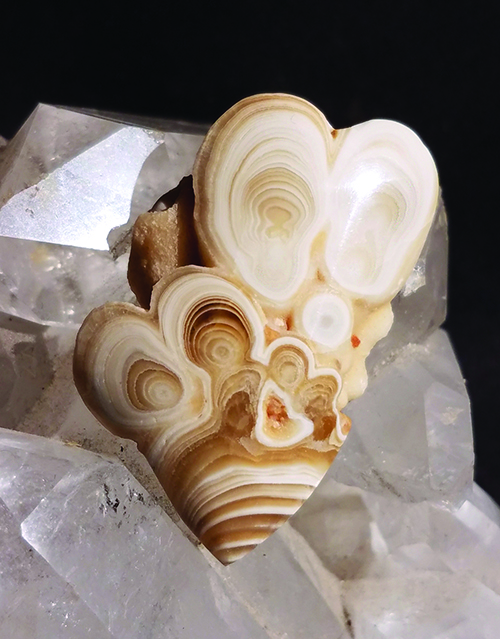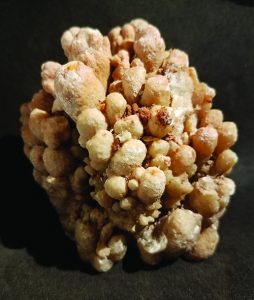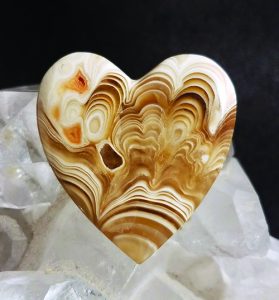
Kokoweef Cave onyx, also known as “cave popcorn”, is a stalactite found in the Kokoweef Cavern in Southern California. It can be made into some very beautiful cabochons, either in classic shapes or natural, free-form shapes.
I recently spoke to Ralf Meithe, President of the Bullhead City Rock Club and volunteer archeologist at Kokoweef, who gave me some good information on this cave onyx. This material consists mainly of calcite and aragonite, and the formations started to grow as far back as the Jurassic Period, 155 million years ago. There’s also a hidden surprise to this material. If you hold a piece under an ultraviolet light, you will see it glow a fluorescent green.
The Kokoweef cavern is closed to the public, but the material can still be found online or at rock shows.
Figuring Out the Pattern
 Since the main component of Kokoweef Cave onyx is calcite, it tends to be soft and will cut and shape rather easily. Before cutting your material into slabs, it’s best to figure out what type of patterns you want first. When holding the material in your hands, you will see one end that looks like it’s dripping; that’s the bottom of the stone. If you cut across the top, you can get some really nice cross patterns with smaller floating orbs, but if you decide to cut vertically, you will get some really beautiful flowing patterns in earthy tones, sometimes even with red bands.
Since the main component of Kokoweef Cave onyx is calcite, it tends to be soft and will cut and shape rather easily. Before cutting your material into slabs, it’s best to figure out what type of patterns you want first. When holding the material in your hands, you will see one end that looks like it’s dripping; that’s the bottom of the stone. If you cut across the top, you can get some really nice cross patterns with smaller floating orbs, but if you decide to cut vertically, you will get some really beautiful flowing patterns in earthy tones, sometimes even with red bands.
I try both approaches, cutting a few slabs from the bottom and then a few from the sides to get a variety of patterns to make cabochons. Note that, if you cut vertically, there is a tendency for portions to break off the main specimen.
Cabbing the Kokoweef Cave Onyx
Once your slabs have been cut, you can figure out what cabochon shapes you’d like to cut, and experiment by utilizing the natural fingers coming down from the stalactites as free-form cabs.
The cabbing process for solid pieces with typical, classic shapes doesn’t need any extra steps; they tend to be very easy to cab. One thing to keep in mind, however, is that the material is generally soft, and starting on a less aggressive wheel is recommended.
Free-Form Approach
If you plan on trying a free-form cabochon, you can choose to keep the natural edges or form a girdle on the sides. Sometimes, making flat cabs with natural edges can be aesthetically pleasing to a jewelry designer who likes to mount cabs using prongs. Others will like an average 3mm girdle to mount, as most silversmiths do.
Either way, this material can be a challenge and a lot of fun to work with. I like to work some of the free forms with a 3mm girdle and a dome. When starting, I shape the bottom into either a “V” shape or a rounded teardrop shape so the designer can securely mount the stone, then I dome over the material cautiously over all the natural shapes and try to keep a uniform dome across the entire stone.
to work some of the free forms with a 3mm girdle and a dome. When starting, I shape the bottom into either a “V” shape or a rounded teardrop shape so the designer can securely mount the stone, then I dome over the material cautiously over all the natural shapes and try to keep a uniform dome across the entire stone.
Kokoweef Cave onyx can be polished to a mirror shine without much effort and without the need for any additional polishing compounds.
This What to Cut column about Kokoweef Cave onyx previously appeared in Rock & Gem magazine. Click here to subscribe. Column by Russ Kaniuth.















